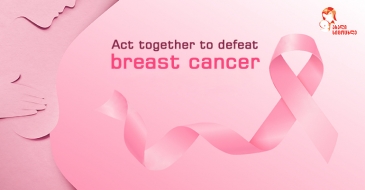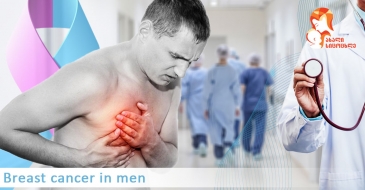New Life Clinic
Mammary gland cancer is one of the most prevalent diseases among women. Tamta Gabriadze, a mammologist and soft tissue oncologist at the „New Life” Clinic, discusses this subject in depth.
Georgia and the World Against Breast Cancer
Breast cancer is the most frequent type of cancer in the world, with over 2.2 million reported cases in 2020. Breast cancer is prevalent in all nations and women of all ages, but there is an increase after the age of 40.
According to the World Health Organization, malignant breast cancer is the primary cause of mortality from malignant neoplasms in women in Georgia. In our country, approximately 1300 new cases are registered each year. It is worth noting that the most dangerous - HER2 - receptor-positive breast cancer is detected in 20-25 percent of cases.
The only way to prevent the recurrence of breast cancer mortality is to detect it early. Mammographic testing is regarded as the gold standard for early detection (average in individuals over 40 years).
-How does breast cancer occur?
-Breast cancer develops in the mucous cells (epithelium) of the ducts (85%) of the breast tissue lobules (15 percent ). Initially, tumor growth is limited to the duct or section ( „in situ local cancer”), where it usually causes no symptoms and has a low risk of spreading (metastases).
Local - in situ (stage 0) cancer can progress over time and invade surrounding tissue (invasive breast cancer), before spreading to nearby lymph nodes (regional metastases) or other organs in the body (distant metastases).
Breast cancer treatment can be quite effective, especially when the illness is diagnosed early. To assist in prolonging life and improving quality of life, breast cancer treatment frequently consists of a mix of surgery, radiation therapy, and medication (hormone therapy, chemotherapy, and/or targeted biotherapy).
-Who is at risk of developing breast cancer?
-Breast cancer is not an infectious illness, as opposed to several cancers that have infection-related origins, such as human papillomavirus (HPV) infection and cervical cancer. It is unknown if specific viral or bacterial infections are linked to the development of breast cancer.
Approximately half of all breast cancer cases occur in women who do not have any identifiable breast cancer-causing variables other than gender (female) and age (over 40 years).
Factors that increase the risk of breast cancer are:
- Increasing age;
- Obesity;
- Detrimental alcohol consumption;
- Family history of breast cancer;
- Exposure to radiation in the past;
- Reproductive history (late menstruation and late first pregnancy);
- Tobacco consumption;
- Postmenopausal hormone therapy.
The most powerful risk factor for breast cancer is the female gender. Men account for about 0.5-1 percent of all breast cancer cases. Men's breast cancer treatment follows the same management concepts like women's.
A family history of breast cancer raises the risk of the disease, however, the majority of women diagnosed with breast cancer do not have the disease's hereditary origins.
The absence of a cancer-related family history does not necessarily suggest that the woman is not at risk.
In some inherited situations, gene mutations (degeneration) of the BRCA1, BRCA2, and PALB-2 genes dramatically enhance the risk of breast cancer.
Women who have mutations in these genes may choose to pursue risk-reduction treatments such as breast cancer preventative surgery. Given the invasive nature of the procedure, it affects only a small proportion of women. All alternatives should be carefully explored, as should other reproductive factors such as concomitant diseases, lactating age, possible lactation status, and so on.
Signs and Symptoms
- Breast cancer or stiffening.
- Change in breast size, shape or, appearance;
- Deepening, redness, the emergence of wrinkles, or other changes on the skin;
- Changes in the appearance of the breast or changes in the skin around the breast (areola) and/or abnormal discharge from the breast;
- Breast cancer is caused by a variety of factors, 90 percent of which are non-cancerous and belong to non-cancerous breast diseases.
If you see any of these symptoms, contact your doctor right away.
The following factors reduce the incidence of breast cancer by 30%:
- Prolonged breastfeeding - more than 1 year;
- Regular physical activity;
- Weight control;
- Abstaining from dangerous alcohol usage;
- Abstaining exposure to tobacco smoke;
- Abstaining from long-term hormone use;
- Abstaining from excessive radiation exposure;
- Breast cancer referrals made on time, or regular visits to a specialist over the age of 40.
-What is mammography?
-Mammography is a type of X-ray that shows an image of the breast. It is used by doctors to detect early signs of breast cancer. Regular mammography is the most effective technique to detect breast cancer early.
-What does it mean to have a firm breast?
-Mammography reveals how solid your breasts are, or how densely the sebaceous structures are packed into the homogeneous composition of the breasts. When you receive mammography results, you may also be told whether your breasts have a low or high density; a high density normally declines with age.
-How is breast cancer diagnosed?
-Additional tests are frequently used by doctors to identify or diagnose breast cancer.
In particular, invasive biopsy followed by morphological evaluation, as well as non-invasive procedures such as mammography, ultrasound, and others.
Computed tomography (CT), magnetic resonance imaging (MRT), and positron emission computed tomography (PET/CT) are examples of specific radiological examinations.
-What is the treatment for breast cancer?
-A doctor's meeting with a surgeon-mammologist, clinical oncologist (chemotherapist), and a radiation oncologist (radiation therapist) is held to choose the breast cancer therapy strategy.
The method of treatment for breast cancer is determined by the stage of the disease. Modern breast surgery protects the body's integrity and attractiveness to the greatest extent possible, early detection of the disease allows for breast-conserving operations, which improves the quality of a woman's psycho-emotional condition.
Remember that breast cancer, like many other types of cancer, is treatable if identified at an early stage!
Cancer is not a verdict!
„New Life” Clinic wishes you health!
Give us a call








